Spitzer Finds Evidence of Violent Planetary Collision
One of the main theories of how our Moon formed involves a violent cosmic collision between two planets. Astronomers
have only been able to hypothesize what this collision was like, but
now they have a better idea of what would ensue after such an event.
With its infrared eyes the Spitzer Space Telescope has found the aftermath a collision between two planets, and what it
shows is brutal. "This collision had to be huge and incredibly
high-speed for rock to have been vaporized and melted," said Carey M.
Lisse of the Johns Hopkins University Applied Physics Laboratory, "This is a really rare and short-lived event, critical in the formation of Earth-like planets and moons. We're lucky to have witnessed one not long after it happened."
Watch the animation/recreation of the event in the video above.
Click to continue…
Sun, Earth Are Unlikely Pair to Support Life
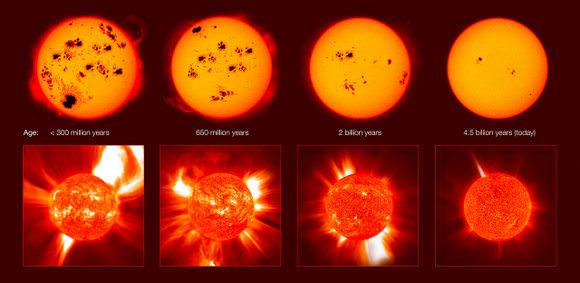
The violent youth of solar proxies. Courtesy of IAU.
We don't know how lucky we are — really.
We know the interaction between Earth and the Sun is a rarity in that it allowed life to form. But scientists working to
understand the possibility that it could have happened elsewhere in the Universe are still far from drawing conclusions.
What is becoming clearer is that life probably shouldn't have formed here; the Earth and Sun are unlikely hosts.
Click to continue…
Early Black Holes Are Starving, Not Feasting
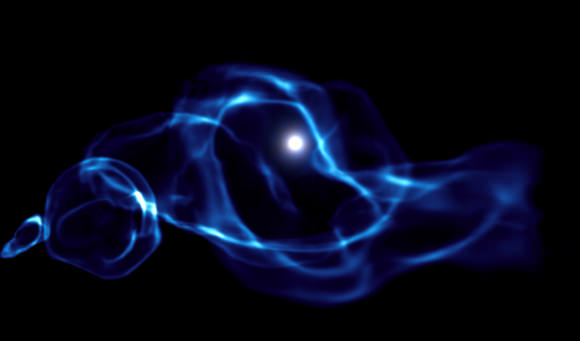
Credit: KIPAC/SLAC/M. Alvarez, T. Abel and J. Wise
A new black hole may not voraciously devour nearby gas — because it
may kick out most of the gas in its neighborhood, a new study shows.
Click to continue…
Planet Precursors May be Sized Like Trucks, Not Towns
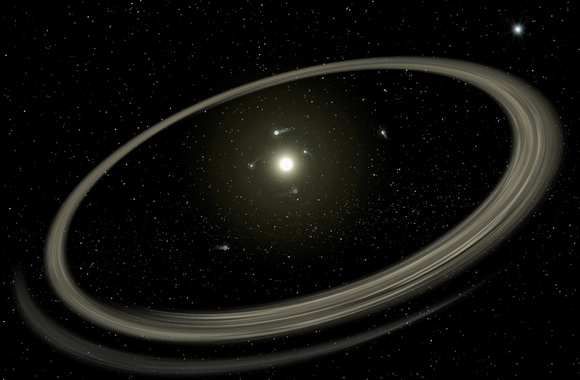
Credit: NASA/JPL-Caltech/T. Pyle (SSC-Caltech)
A typical model has planets forming from collisions of material swirling around stars. But new laboratory experiments indicate the colliding bodies may be much smaller than most people have thought.
Click to continue…
Astro Art of the Week

Here's the fifth edition of our new feature, showcasing our readers'
prowess with image editing software. This week's Astro Art of the Week
a conglomeration of several images created by Aaron Nako. "The blue
background with vertical lines is actually a distorted and
colour-adjusted picture of the Carina nebula," Aaron wrote, "and the
stars in the electricity/waves are from a picture of NGC 6384 taken
from the Rancho Del Sol Observatory. The grunge darker blueish bit
coming from the top right-hand corner is actually our sun. The stars
were Photoshop brushes that I changed a little bit."
Thanks for sharing your photo-editing wizardry Aaron! If you've got a space or astronomy image you've created and would like to share it, submit it to Nancy . We're also still mulling over what to call this new feature — so if you have any suggestions, post your idea in the comments.
Have You Ever Seen a Moonbow?
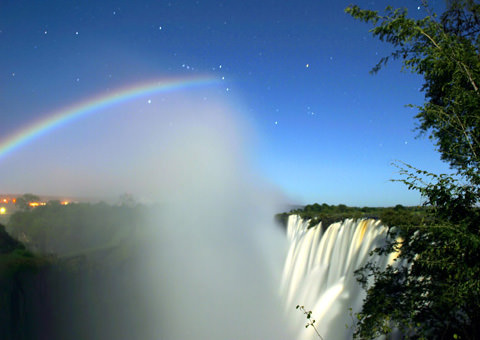
They are elusive, but powerful to see. "Moonbows" are rainbows created by light from the Moon.
Conditions have to be just right, and there are only a small number of
places in the world where they regularly materialize, such as Victoria
Falls on the border between Zambia and Zimbabwe as seen above,
Cumberland Falls in Kentucky, Yosemite Falls in California, and Waimea
on Hawaii. Because they are so faint, moonbows are difficult to see
with the naked eye (they usually appear just white). But with
long-exposure photography, all the colors of moonbows can be seen.
Below, check out a gorgeous video of stars, a moonbow and rainbow over Torres del Paine in Patagonia, Chile, and more moonbow images at Environmental Graffiti.
Click to continue…
2009 Perseid Meteor Shower – Double Peaks This Year!
Are you ready for this year's Perseid Meteor Shower? What will be
the best place to watch and when will be the best date to see the most "shooting stars"? Follow along and let's find out… Click to continue…
Current Moon Phase

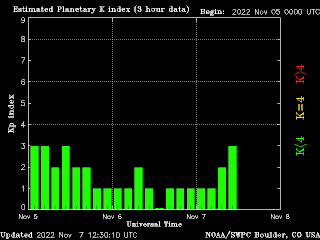
Current Solar Data From NOAA Â


Astronomy Picture of the Day NASA Â

Saturn's Rings to Disappear Tuesday  Space.com - August 11, 2009  
Meteorite mineral made in the lab  BBC - August 11, 2009 Â
Mars, methane and mysteries  PhysOrg - August 11, 2009 Â
Dark Matter May be Easier to Detect than Previously Thought  PhysOrg - August 11, 2009 Â
  First black holes born starving  PhysOrg - August 11, 2009 Â
 First black holes born starving  PhysOrg - August 11, 2009  
  Planet Smash-Up Sends Vaporized Rock, Hot Lava Flying  PhysOrg - August 10, 2009
 Planet Smash-Up Sends Vaporized Rock, Hot Lava Flying  PhysOrg - August 10, 2009

Meteorite mineral made in the lab  BBC - August 11, 2009 Â

Mars, methane and mysteries  PhysOrg - August 11, 2009 Â

Dark Matter May be Easier to Detect than Previously Thought  PhysOrg - August 11, 2009 Â

  First black holes born starving  PhysOrg - August 11, 2009 Â
 First black holes born starving  PhysOrg - August 11, 2009  
  Planet Smash-Up Sends Vaporized Rock, Hot Lava Flying  PhysOrg - August 10, 2009
 Planet Smash-Up Sends Vaporized Rock, Hot Lava Flying  PhysOrg - August 10, 2009 Hole in the Earth  Live Science - August 10, 2009 Â


A meteorite
that rocked the Sahara desert over 300 million years ago left behind
quite a scar that's been photographed before. The Aorounga crater is
spproximately 345-370 million years old based on the age of the
sedimentary rocks deformed by the impact.
EARTHQUAKES
  Tsunami watch issued for five countries canceled  CNN - August 10, 2009 Â
 Tsunami watch issued for five countries canceled  CNN - August 10, 2009  
  USGS: huge 7.6 earthquake hits in Indian Ocean  AP - August 10, 2009 Â
 USGS: huge 7.6 earthquake hits in Indian Ocean  AP - August 10, 2009  

Magnitude 7.1 earthquake strikes Japan coastÂ
CNN - August 9, 2009 Â

IRIS Seismic Monitor USGS Ongoing Updates and Links



